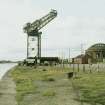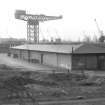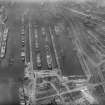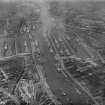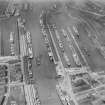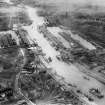Glasgow, Stobcross Quay, Finnieston Cantilever Crane
Crane (20th Century)
Site Name Glasgow, Stobcross Quay, Finnieston Cantilever Crane
Classification Crane (20th Century)
Alternative Name(s) Lancefield Quay; River Clyde
Canmore ID 44033
Site Number NS56NE 123.01
NGR NS 57103 65151
Datum OSGB36 - NGR
Permalink http://canmore.org.uk/site/44033
- Council Glasgow, City Of
- Parish Glasgow (City Of Glasgow)
- Former Region Strathclyde
- Former District City Of Glasgow
- Former County Lanarkshire
The Finnieston or Stobcross Giant Cantliever Crane by Cowans Sheldon and Co. of Carlisle and Cleveland Bridge and Engineering Co. (cantilever) was buit in 1931 (operating from 1932).
One of four surviving on the Clyde, the other three being: formerJohn Brown Shipyard, Glasgow (Sir Wiliam Arrol and Co., 1907, 150 Tons); Watt Dock Greenock, Inverclyde (Sir Wiliam Arrol and Co., 1917, 150 Tons) and former Barclay Curle North British Diesel Engine Works, South Street, Glasgow (Sir William Arrol and Co., 1920, 150 Tons), it is one of 11 surviving worldwide.
Infrmation from RCAHMS (MMD), 28 July 2014.
Queen's Dock, 1882, James Deas
The opening of the Queen's Dock and the railway spelt the end of Stobcross House and Finnieston. Cut and built in Giffnock stone, the Dock transformed the area into a city service centre, legacies of which are still evident. It was filled for the Scottish Exhibition Centre. Only the Finnieston Crane, 1932, by Cowans Sheldon, now recalls the mercantile bustle. The crane could load railway engines and tanks on to cargo ships, which is said to be one reason for its survival. Otherwise the engineering works have gone.
Taken from "Greater Glasgow: An Illustrated Architectural Guide", by Sam Small, 2008. Published by the Rutland Press http://www.rias.org.uk
NS56NE 123.01 57103 65151
Field Visit (13 May 2015 - 14 December 2015)
Though derigged and no longer operational, the crane has been used for several high profile arts projects. One of the most well-known took place in 1987, when the artist George Wyllie used the crane to suspend a straw locomotive for eight weeks, before being ceremoniously burned. In 2013, artist Bill Fontana captured the sounds of the crane by attaching microphones to it, turning it into a musical installation in a project commissioned by the Glasgow UNESCO City of Music project. The crane features prominently as part of a newly redeveloped riverscape, and forms part of the backdrop to BBC and STV news broadcasts.
Visited by RCAHMS (AGCH) 13 May 2015, Information from Martin Conlon 14 December 2015.







































